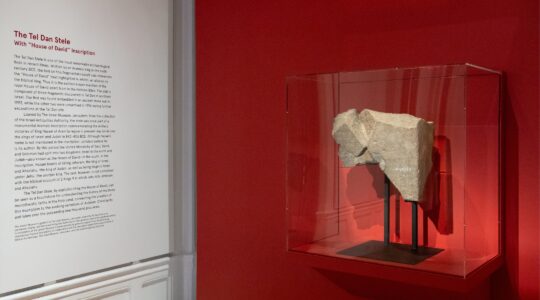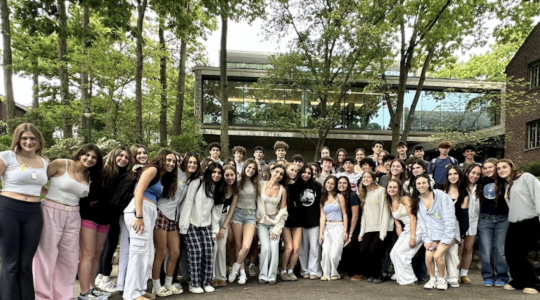“Zorg zich nit,” she said. “Don’t worry.”
It was in November 2016 that my grandmother started teaching me Yiddish. When she shared those wise words with me, an anxious mess of a teenage boy from San Antonio, I didn’t realize it, but my grandmother had sparked a curiosity and passion in my own culture that I had never felt before — I began the Jewish journey that she embarked on years ago.
Born Sandra Miller, the woman I call Nana was the daughter of two Polish Jews: Harry, who immigrated through Ellis Island as a congenial teenager with nothing but the clothes he wore across the Atlantic; and Mary, stubborn and intelligent, who learned to fend for herself from the age of 5 when she alone guided her blind grandfather on the journey to America. The two married and saved everything they had until they could buy a small, four apartment building in Brooklyn, where they raised their children with the values quintessential to the Jewish immigrant’s parenting style — an emphasis on education and a strong work ethic.
My grandmother, however, was a girl living under an Orthodox roof, so, as part of the status quo, she never received a proper Jewish education. She picked up what she could from her siblings who studied Hebrew and the Torah — it was the best and only way to scrape together any knowledge about her culture — but the real connection to her Jewish roots was through the Yiddish language.
A hybrid language between Hebrew and German, Yiddish was the vernacular of the Eastern European Jewish community throughout the 19th- and early 20th-centuries. Yiddish was not only a language, but a quintessential feature of the growing separatism between the Jews and the rest of Poland, Russia, and Germany. As the Nazi party in Germany rose to power, the Jews stopped being part of Eastern Europe; they were a lone battalion, and they were in enemy territory. Yiddish was spoken behind closed doors, in hushed tones.
Meanwhile, across the Atlantic, my grandmother sat tacitly on the linoleum floor in a Brooklyn apartment, her ear to the door of her parents’ bedroom. As she listened to the whispers that billowed up from under the door, accompanied by Mary’s cigarette smoke that made the nosy teenager’s eyes water, Sandra started piecing together the Yiddish language in its natural context: in secret. The two kvetched, complained, about business, family, gossip, or whatever they could think of — the stingy tenant who hadn’t paid his rent in three months; the neighbor who had enrolled in welfare; who was a mensch, a selfless person, and who wasn’t. For years she listened, and throughout her life, she, and later I would become deeply influenced by these two hard-working immigrants achieving the American dream, and by the language they spoke.
For more than half her life, my grandmother was surrounded by people with incredible stories. She earned a doctorate in psychology, ran a senior center and later a private psychotherapy practice. She met Holocaust survivors who never came to the center without a smile, and divorces who needed their weekly therapy appointment with her more than they needed food or water. In adulthood she was back to listening, just as she had done throughout her childhood. But now instead of learning of her rich background, she learned others’ stories and others’ cultures — until about five years ago when she closed her practice and decided to find her own story.
Nana enrolled in classes on Jewish history and the Torah at Temple Emanu-el on Fifth Avenue and the Eldridge Street Synagogue. Her classes made her feel like a part of the Jewish community that neither she nor her family had the time to be a part of in the past. The love she felt in this environment sparked a revelation for her that inspired a passion to share her knowledge of the Jewish faith and culture with others. Within a month she was on a flight to my home in San Antonio.
I had always identified as a Jewish person, but for 13 or so years it was reduced to just that — a name. I had been to temple twice in my life, one of which was for my bar mitzvah, and I couldn’t name three kings of Israel if my life depended on it. I would go as far to say that I have strong morals, but I didn’t have any culture to base them in. I was a sprawling tree with no roots — that is until my grandma stepped into our house with the same genuine smile and silver suitcase she brought every time with her to Texas. She unpacked her sidewalk-weathered white sneakers as well as the rest of her neatly folded clothes, sat down on the swiveling arm chair in the living room, and with a smirk said, “Matthew, do you know the story of Moses?”
We talked for three hours.
Over the next few years I looked forward to speaking with my grandma about her classes. In 2016, after five years of intermittent discussion, I found myself on 23rd Street and 2nd Avenue resting my head on the cushion of a new red leather couch, exhausted from the five-hour journey to New York.
It was six in the evening, and the sun was beginning to set as my grandma turned the corner from her bedroom and walked in just as my mom and I were kvetching, just as Mary and Harry did, save the cigarette smoke. She stood there in the opposite corner, in front of a mirror, quietly listening as she put in her small gold earrings. After she was finished, she walked across the room towards the door as we continued to vent, slung her purse over her shoulder, looked at us and in a nonchalant manner, shrugged her shoulders, saying “eh, nisht gefloygen.”
Support the New York Jewish Week
Our nonprofit newsroom depends on readers like you. Make a donation now to support independent Jewish journalism in New York.
My mother and I looked at each other confused. Was she having a stroke? She looked at us like a teacher looks at an inattentive student struggling at the whiteboard. I saw something in her eyes that looked like she had brought back to mind a cherished memory. “What did you say?” I asked, breaking the silence.
“Nisht gefloygen,” she repeated, holding back a smile, “it doesn’t matter. Complaining isn’t going to get you anywhere — let it go. You can’t change who a person is, you have to work with what you’ve got. Nisht gefloygen.” She turned around, threw a scarf around her neck, and was out the door.
That remark lingered in my ears the rest of the night as if it followed me with the icy wind whipping around the Lower East Side brick buildings. How could one phrase be so simple, but have so much meaning behind it? I put my curiosities into words over delicious lo mein and egg-drop soup after the 10 block walk (a huge trek for a San Antonio resident whose day is ruined by a crowded parking lot) to a small, conservatively decorated noodle house. “How much Yiddish do you know, grandma?” I inquired, fascinated.
“Oh, I used to know much more when my parents were still alive. I was almost fluent — that is, I could understand it fluently. I wasn’t very fluent in speaking it, but I didn’t speak much in any language as a kid.” I immediately saw the same nostalgia-induced twinkle in her eye that I saw in the apartment. “I do remember a few phrases though.”
“Can you teach me some?”
From then on, Nana taught me Yiddish in an opposite fashion to the way she was taught: deliberately. The same passion for others that the people of the senior center saw in my grandma over a decade ago I saw in her that day. She fervently sought to teach me something that she thought could help me understand not only my own culture but the world around me, and she was right in doing so.
The reluctant optimism that characterizes the tough, strong-willed, yet resigned attitude of many of those who spoke Yiddish in 20th-century America is reflected in the language and made an impression on me. Every week, Nana texted me Yiddish phrases: umglik bindt tsunoif, misfortune binds people together, far gelt bakmut men alts, nor kain saichel nit, money buys everything except brains, di oi’eren heren nit vos moil redt, the ears don’t hear what the mouth utters. Although they seem simplistic, these phrases have helped me through the hardships that come with being a student, a teenager, and a friend. I find solace in my Yiddish, a refuge in the gray area between optimism and cynicism. Yiddish embodies the reconciliation of dreams and reality, the intellect and strength of my people, and the bond between generations for which I am incredibly grateful.
After all, when I’ve had an especially rough day, I still whisper, just loud enough for Harry and Mary to hear,
Zorg zich nit, nisht gefloygen.
The New York Jewish Week brings you the stories behind the headlines, keeping you connected to Jewish life in New York. Help sustain the reporting you trust by donating today.




